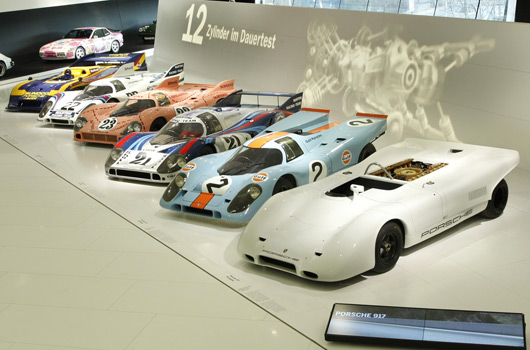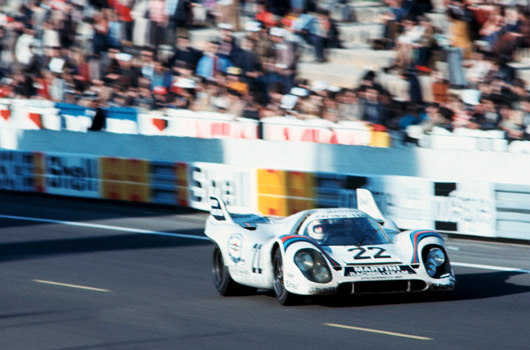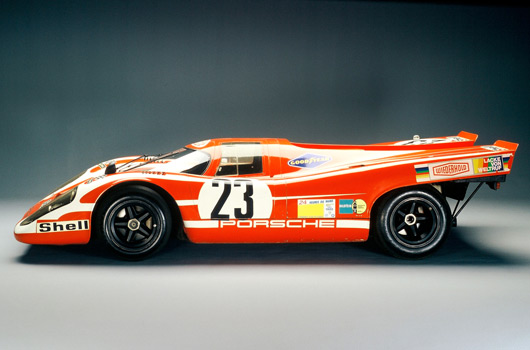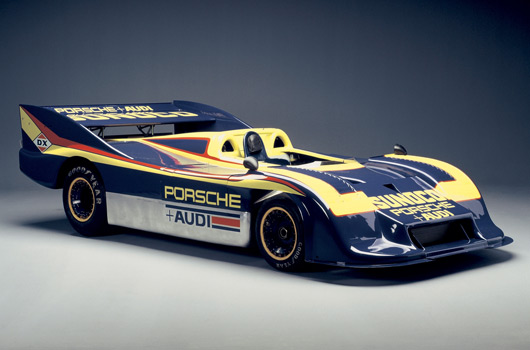The famous Porsche 917 racing car turns 40 this year. Porsche will hold special birthday celebrations for the 917 at this year’s Goodwood Festival of Speed (3–5 July).
The theme for the FoS this year is ‘True Grit – Epic Feats of Endurance’. It is appropriate then that among the 917’s many achievements are back-to-back 24 Hours of Le Mans victories in 1970 and 1971. These results marked Porsche’s first successes at the world’s oldest sports car race.
The 1971 triumph set a new record for the fastest ever victory at Le Mans, the Martini Racing Team 917, driven by Helmut Marko and Gijs van Lennep, completed 397 laps, or 5335.313km (3313 miles), at an average speed of 222km/h (138mph). That record still stands. (HERE is a full list of Le Mans winners).
For more on this epic 12 cylinder powered legend described by British magazine Motor Sport as the ‘greatest racing car in history’, read the press releases below, or check out Wikipedia.
Porsche celebrates endurance with iconic 917 and world record attempt at 2009 Goodwood Festival of Speed
For many car enthusiasts and automotive historians, the Porsche 917 is the ultimate long distance endurance racer. The 917 has a place in the record books not only as the first Porsche to win the Le Mans 24 Hours outright in 1970, but the 917 also scored the fastest ever victory at the French classic in 1971 covering 3,313 miles in 24 hours at an average speed of 138mph.
This iconic sports car, which celebrates its 40th anniversary this year, is the perfect embodiment of the theme of this year’s Goodwood Festival of Speed (July 3 -5) which is ‘True Grit – Epic Feats of Endurance’. Examples of the 917 – and many other Porsche cars from past and present – will once again thrill spectators at the summer-time motoring extravaganza held in the grounds of Goodwood House, near Chichester, Sussex.
This year’s Festival will also provide the setting for another demonstration of Porsche endurance, grit and determination. An attempt on the world record for the longest distance covered in 48 hours by a team of 12 runners using treadmills will take place live at the Porsche exhibition area over the Festival weekend. Organised by the sports scientists from Human Performance facility at the Porsche Driving Experience Centre, Silverstone, this gruelling athletic exercise will seek to break the former distance record of 495.76 miles set by the Runners World Forum Squad in April 2008.
Celebrating 40 years of the Porsche 917
Forty years ago on March 13, 1969, at the Geneva International Motor Show, Porsche unveiled a car that, even by today’s standards, is underestimated when it is described as the ‘super sports car’. The Porsche 917 subsequently became a legend as one of the fastest and most successful racing cars of all time, and its 40th anniversary is celebrated this year with a special exhibit at the new Porsche Museum in Stuttgart and a 917 display at the 2009 Goodwood Festival of Speed (July 3–5).
Porsche fired the starting shot for Project 917 in June 1968, after the international motor sports authority announced a class of ‘homologated sports cars’ with up to five litres engine capacity and a minimum weight of 800kg. Under the supervision of Ferdinand Piëch, the stipulated 25 units of the new racing car model were completed by April 1969 so that the 917 could begin its racing career in the same year. After it initially dropped out of its first three races due to technical problems, the 917 success story began in August 1969 with victory at a 1,000-kilometre race at the Österreichring driven by Jo Siffert and Kurt Ahrens.
The engine configuration of the 917 was just as unusual as the different body styles the car was presented in. Behind the driver’s seat lay an air-cooled, twelve-cylinder engine with horizontal cylinders, whose crankshaft designated it as a 180-degree V engine. The 520 hp engine had an initial cubic capacity of 4.5 litres. The tubular frame was made of aluminium, the car body out of glass fibre reinforced synthetics.
Porsche engineers developed different body styles to best meet the different demands of different race track configurations. The so-called short-tail ‘Kurz’ model was designed for heavily twisting circuits in which a high tyre contact pressure was necessary for fast cornering. The long-tail ‘Langheck’ model was designed for fast race tracks and an ultimate high top speed. These were followed by the open 917 Spyders, which were used in the CanAm and Interseries races.
At the end of the 1970 race season, Porsche confirmed its superiority with the 917 and 908/03 models, winning the Racing Series World Championship [Markenweltmeisterschaft] in nine out of ten possible victories. This series of victories began at Daytona and continued at Brands Hatch, England, Monza, Italy, Spa, Belgium, on the Nürburgring race track in Germany, at the Targa Florio in Sicily, at Le Mans, France, Watkins Glen, United States of America, and the Österreichring, Austria. However, the season’s high point was the long-desired overall win of the Le Mans 24-hour endurance race, a trophy that Hans Herrmann and Richard Attwood brought home to Zuffenhausen on June 14, 1970. Their 917 short-tail model painted in the Porsche Salzburg colours of red and white, with the start number 23, not only successfully defied its competitors but also the heavy rainfall.
As in the previous year, the 1971 season was dominated by the 917 model so that the Racing Series World Championship went to Porsche again with eight out of ten race victories. And once more, a Porsche 917 was victorious at the Le Mans 24-Hour race – this time with Gijs van Lennep and Dr Helmut Marko, who set a world record with an average speed of 138mph (222 km/h) and 3,313 miles (5,335km) driven, a record that still stands today. One special feature of their 917 short-tail model, visually characterised by its ‘shark fin’, was the tubular frame made of magnesium.
A 917 long-tail coupe model set a further record in 1971. On the Mulsanne straight, which is part of the route in the Le Mans 24-Hour race, the sports car with the start number 21 recorded the highest speed of 240mph (387 km/h). Another Le Mans race car achieved major recognition. The Porsche 917/20 was a mix between the short-tail and the long-tail models and was notable for its broad proportions. Although the pink coloured racecar, nicknamed ‘the Pig’, dropped out halfway through the race, its unusual paint colour made it one of the most famous Porsche models ever.
When the European FIA regulation for the ‘five-litre sports car’ expired at the end of the 1971 season, Porsche decided to enter the Canadian American Challenge Cup (CanAm). In June 1972, the private Penske race team used the turbo-charged Porsche 917/10 Spyder for the first time. With performance of up to 1,000 hp, the Porsche Spyder dominated the race series and won for Porsche the CanAm championship with victories at Road Atlanta, Mid Ohio, Elkhart Lake, Laguna Seca and Riverside.
In the following year, the 1,200 hp 917/30 Spyder had its racing premiere. The superiority of the monster car driven by Mark Donohue was so obvious that the regulations of the CanAm series had to be changed in the end in order to exclude the 917/30 from competing further in the 1974 season. However, as is typical for Porsche, the technologies for increasing performance developed for these races were successfully transferred to the sports cars for the road. That’s how the 911 Turbo, with its side-exhaust turbocharger, began its career in 1974 and has been, since this time, a synonym for the performance capacity of the Porsche sports car.
To date, the reputation of the 917 is legendary. Indeed, 50 international motor sports experts from the famous British magazine ‘Motor Sport’ nominated the 917 as the ‘greatest racing car in history’.
All in all, Porsche built 65 units of the 917; 44 sports cars as short-tail and long-tail coupés, two PA Spyders as well as 19 sports cars as CanAm and Interseries Spyders with up to 1,400 hp turbo engines. Seven of the most important 917 models – among them the Le Mans victory cars from 1970 and 1971 and the 917/30 Spyder – are currently exhibited in the new Porsche Museum in Stuttgart.




3 replies on “Porsche 917 celebrates 40th birthday”
[…] english enjoy http://www.ausmotive.com/2009/03/20/…-birthday.html (click the pics) Cheers Peter __________________ BJ43/1980 OEM Softop ~ FJ45 LPB/1973…. old […]
Still now, nothing even comes close.
Thanks to Pedro, Derek , Gerard and Seppi.
[…] Classic cars are another great reason to attend the FoS and this year the event will be headlined by the legendary Porsche 917. […]